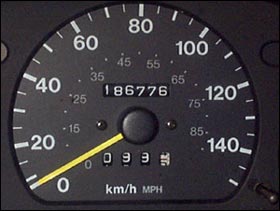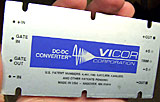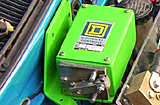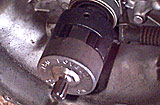6000 km since conversion: what have we learned?

Posted October 4, 2011 ...
Next week marks the 4th "re-birthday" of the ForkenSwift. That's four years and 6000 kilometers (about 3700 miles) of electric motoring since being converted and legally registered as an EV.
Seems like a good opportunity to look back and ponder some of the big questions:
- How reliable has it been?
- How much gasoline has been saved vs. electricity used?
- Any lessons learned? What would I do differently?
- What's the future of the ForkenSwift?
- - -
1) How reliable has it been?
In a nutshell: vastly more reliable than the gasoline car it used to be!
 |
| The old 3-cylinder engine was worn out and not very reliable |
Before electric conversion, this car's gas engine & related systems were getting worn out: the engine was tired, it burned oil, and needed a serious tune-up; the gas tank and fuel lines were getting rusty; and the exhaust system was starting go.
The fact is, for those reasons the previous owner was planning to send the car to the junkyard. Keeping it as a gas car would have been too expensive and inconvenient.
But as an electric car, it's been very reliable. In four years, there have only been a handful of minor problems (one per year, on average) and none of them expensive to fix:
- One "breakdown": this was my fault and happened just this summer. A poorly routed and un-fused wire to the DC-DC converter chafed against the chassis. It wore through the wire insulation, charring it and releasing some smoke (and stink). This was the only time I've had to press the car's emergency battery disconnect (the clutch pedal), at which point I rolled to the side of the road and popped the hood.
After a few minutes of investigation, I saw the problem wasn't mission critical. So I cleaned up the short circuit and charred wire, reconnected the battery pack electrical cable, and continued on my way (minus the DC-DC).
 DC-DC converter module: this wasn't related to the above issue - the first one quit working well before the short circuit. I'm not entirely sure what went wrong with it, other than it looked like the magic smoke got let out somehow. It cost about $25 to replace with another with the same specs.
DC-DC converter module: this wasn't related to the above issue - the first one quit working well before the short circuit. I'm not entirely sure what went wrong with it, other than it looked like the magic smoke got let out somehow. It cost about $25 to replace with another with the same specs.
 Potentiometer adjustment: in the car's first year, a set screw on the home-made potentiometer arrangement slipped, so the accelerator went out of adjustment. The car wouldn't go until the pedal was pressed well down into its travel. This was a 10 minute fix.
Potentiometer adjustment: in the car's first year, a set screw on the home-made potentiometer arrangement slipped, so the accelerator went out of adjustment. The car wouldn't go until the pedal was pressed well down into its travel. This was a 10 minute fix.
 Motor/transmission coupler adjustment: another set screw problem! The screw that holds half of the LoveJoy coupler in place on the transmission input shaft doesn't quite hold. So the two halves of the coupler slowly creep apart in regular use, and need to be re-set every couple of months - it's a 10 minute procedure. For a permanent fix, the traction motor needs to come off, and at some point this will happen.
Motor/transmission coupler adjustment: another set screw problem! The screw that holds half of the LoveJoy coupler in place on the transmission input shaft doesn't quite hold. So the two halves of the coupler slowly creep apart in regular use, and need to be re-set every couple of months - it's a 10 minute procedure. For a permanent fix, the traction motor needs to come off, and at some point this will happen.
 Batteries: these haven't really been a "problem", but they have been replaced, so I'm including them in the list.
Batteries: these haven't really been a "problem", but they have been replaced, so I'm including them in the list.
The car is on its 4th(!) pack of used golf cart batteries since it was converted. Not because any of the packs has "worn out" - remember, they were already worn out (used cast-offs) when we got them! Recall that the ForkenSwift only needs 20 km (12 miles) of range to be useful in the small town where it lives. Aside from the first "test" pack, the rest of the batteries have been able to deliver that range, and more. But whenever a "fresh" used batch of batteries has become available, we've snapped them up (usually at scrap prices).
- - -
2) Operating costs: how much gasoline has been saved & electricity used?
A 3-cylinder Metro was a pretty efficient car. I would have gotten about 4.3 L/100 km / 55 mpg (US) / 66 mpg (Imperial) from this car with its gas engine.
So, over 6000 km / ~3700 miles, that works out to:
- $307.85 worth of gasoline not burned
That's 256.5 litres / 67.9 gallons (US) at $1.20 / litre - current Canadian prices)
- $105.30 worth of electricity used
Electricity consumption has been on average 195 watt hours per km, or 318 Wh/mi. At 9 cents per kilowatt hour, that works out to $105.30 in electricity costs (for renewably sourced energy; regular grid power would have been more like $70).
- - -
3) Any lessons learned? What would I do differently?
Regenerative braking
I'm an efficiency enthusiast, so it irks me whenever I have to convert electricity into brake dust/heat.
Most of the time I drive as efficiently as I can. In city driving, that means minimizing the use of the brakes - it's one of the best energy-saving techniques (regardless of whether you're burning electrons or dinosaurs). As an efficiency strategy, coasting to decelerate always beats using regen.
But it's not possible to coast up to every stop or turn - eg. when going down hill, or when there are following drivers (whom you don't want to annoy). For those times I do have to get on the binders, I really wish I had regen.
It is possible - there are a number of ways to rig regenerative braking with a DC system. Even though they add a fair amount of complexity for a relatively small efficiency increase, having regen would make me an even happier EV driver. It's not on the to-do list, though. (Too many other projects!!!)
A solid host vehicle
The ForkenSwift's biggest problem is body rust.
That's really no surprise, given that it's a lightly built, 20 year-old econobox, living in Ontario's rust belt.
The floors and rocker panels are getting kind of ratty, and without some quality time spent with a welder, this car won't be around much longer. It will be taken off the road this winter to keep it away from the salty mess on our roads. One more season soaking in briny slush would kill it.
So, if you're doing a conversion, make sure you get a vehicle that will last.
- - -
4) What's in the future for the ForkenSwift?
Another 6000 km?
Well, the rust will be repaired, as will the always-slipping-apart coupler.
But I'm also keeping my eyes open for another host vehicle. If something cool turns up, the car's guts might find themselves re-incarnated in a more interesting vehicle that's better suited to the way the ForkenSwift is generally used (hauling stuff around town that's too big to carry on my bike!).
Lately I've been dreaming of something like this ...
